Simulation of Vegetation Carbon Sink of Arbor Forest and Carbon Mitigation of Forestry Bioenergy in China
Abstract
1. Introduction
2. Materials and Methods
2.1. Methodology
2.2. Parameters and Data Sources
3. Results
3.1. Vegetation Carbon Sink of Tree Species
3.2. Vegetation Carbon Sink of All Arbor Forests
3.3. Carbon Emission Mitigation of Forestry Bioenergy
4. Discussion
4.1. Comparison with Other Studies’ Findings
4.2. Uncertainty
- There is geographical variability in the growth of arbor forests. Although the parameters of the CO2FIX model had been localized in this paper, the influence of geographical variability on the estimation results cannot be avoided.
- The allocation of new afforestation areas. Variations in vegetation carbon density among different tree species lead to differences in the estimation results under different area allocation schemes.
- The efficiency of bioenergy utilization. Although the actual energy consumption of rural China was considered, this paper set out to use bioenergy as a substitute for coal; however, this was an ideal situation and would deviate to some extent from the actual situation.
- The models used for estimating carbon sinks. The CO2FIX model simulates the forest carbon cycle without considering the disturbances in forest carbon sinks caused by climate change, increased atmospheric CO2 concentrations, and fires, etc. This may also bring uncertainty to the results of this study.
5. Conclusions
Author Contributions
Funding
Institutional Review Board Statement
Informed Consent Statement
Data Availability Statement
Conflicts of Interest
References
- Wei, Y.M.; Chen, K.Y.; Kang, J.N.; Chen, W.M.; Wang, X.Y.; Zhang, X.Y. Policy and management of carbon peaking and carbon neutrality: A literature review. Engineering 2022, 14, 52–63. [Google Scholar] [CrossRef]
- Cai, L.Y.; Luo, J.; Wang, M.H.; Guo, J.F.; Duan, J.L.; Li, J.T.; Li, S.; Liu, L.T.; Ren, D.P. Pathways for municipalities to achieve carbon emission peak and carbon neutrality: A study based on the leap model. Energy 2022, 262, 125435. [Google Scholar] [CrossRef]
- Cai, B.F.; Zhang, L.; Lei, Y.; Wang, J.N. A deeper understanding of the CO2 emission pathway under China’s carbon emission peak and carbon neutrality goals. Engineering 2022. [Google Scholar] [CrossRef]
- Qi, J.J.; Dauvergne, P. China and the global politics of nature-based solutions. Environ. Sci. Policy 2022, 137, 1–11. [Google Scholar] [CrossRef]
- Gómez Martín, E.; Máñez Costa, M.; Egerer, S.; Schneider, U.A. Assessing the long-term effectiveness of nature-based solutions under different climate change scenarios. Sci. Total Environ. 2021, 794, 148515. [Google Scholar] [CrossRef]
- Zhang, X.X.; Wu, L.Y.; Ma, X.Z.; Qin, Y.C. Dynamic computable general equilibrium simulation of agricultural greenhouse gas emissions in China. J. Clean. Prod. 2022, 345, 131122. [Google Scholar] [CrossRef]
- Chu, X.; Zhan, J.Y.; Li, Z.H.; Zhang, F.; Qi, W. Assessment on forest carbon sequestration in the Three-North Shelterbelt program region, China. J. Clean. Prod. 2019, 215, 382–389. [Google Scholar] [CrossRef]
- Li, W.; Zhang, S.H.; Lu, C. Exploration of China’s net CO2 emissions evolutionary pathways by 2060 in the context of carbon neutrality. Sci. Total Environ. 2022, 831, 154909. [Google Scholar] [CrossRef]
- Lin, B.Q.; Ge, J.M. Carbon sinks and output of China’s forestry sector: An ecological economic development perspective. Sci. Total Environ. 2019, 655, 1169–1180. [Google Scholar] [CrossRef]
- Song, Z.L.; Liu, H.Y.; Strömberg, C.A.; Wang, H.L.; Strong, P.J.; Yang, X.M.; Wu, Y.T. Contribution of forests to the carbon sink via biologically-mediated silicate weathering: A case study of China. Sci. Total Environ. 2018, 615, 1–8. [Google Scholar] [CrossRef]
- Zhang, P.Y.; He, J.J.; Hong, X.; Zhang, W.; Qin, C.Z.; Pang, B.; Li, Y.Y.; Liu, Y. Carbon sources/sinks analysis of land use changes in China based on data envelopment analysis. J. Clean. Prod. 2018, 204, 702–711. [Google Scholar] [CrossRef]
- Machado, R.R.; Conceição, S.V.; Leite, H.G.; Souza, A.L.D.; Wolff, E. Evaluation of forest growth and carbon stock in forestry projects by system dynamics. J. Clean. Prod. 2015, 96, 520–530. [Google Scholar] [CrossRef]
- Rosa, C.M.D.; Marques, M.C. How are biodiversity and carbon stock recovered during tropical forest restoration? Supporting the ecological paradigms and political context involved. J. Nat. Conserv. 2022, 65, 126115. [Google Scholar] [CrossRef]
- Yu, G.R.; Zhu, J.X.; Xu, L.; He, N.P. Technological approaches to enhance ecosystem carbon sink in China: Nature-based solutions. Bull. Chin. Acad. Sci. 2022, 37, 490–501. (In Chinese) [Google Scholar] [CrossRef]
- Sun, W.L.; Liu, X.H. Review on carbon storage estimation of forest ecosystem and applications in China. For. Ecosyst. 2020, 7, 37–50. [Google Scholar] [CrossRef]
- Zhao, M.M.; Yang, J.L.; Zhao, N.; Xiao, X.M.; Yue, T.X.; Wilson, J.P. Estimation of the relative contributions of forest areal expansion and growth to China’s forest stand biomass carbon sequestration from 1977 to 2018. J. Environ. Manag. 2021, 448, 113757. [Google Scholar] [CrossRef]
- Ma, X.Z.; Wang, Z. Estimation of provincial forest carbon sink capacities in chinese mainland. Chin. Sci. Bull. 2011, 56, 883–891. [Google Scholar] [CrossRef]
- Tang, X.L.; Zhao, X.; Bai, Y.F.; Tang, W.T.; Zhao, Y.C.; Wan, H.W.; Xie, Z.Q.; Shi, X.A.; Wu, B.F.; Wang, G.X.; et al. Carbon pools in China’s terrestrial ecosystems new estimates based on an intensive field survey. Proc. Natl. Acad. Sci. USA 2018, 115, 4021–4026. [Google Scholar] [CrossRef]
- Stephenson, N.L.; Das, A.J.; Condit, R.; Russo, S.E.; Baker, P.J.; Beckman, N.G.; Coomes, D.A.; Lines, E.R.; Morris, W.K.; Rüger, N.; et al. Rate of tree carbon accumulation increases continuously with tree size. Nature 2014, 507, 90–93. [Google Scholar] [CrossRef]
- Yao, Y.T.; Piao, S.L.; Wang, T. Future biomass carbon sequestration capacity of Chinese forests. Sci. Bull. 2018, 63, 1108–1117. [Google Scholar] [CrossRef]
- Zhao, M.M.; Yang, J.L.; Zhao, N.; Liu, L.; Du, L.; Xiao, X.M.; Yue, T.X.; Wilson, J.P. Spatially explicit changes in forest biomass carbon of China over the past 4 decades: Coupling long-term inventory and remote sensing data. J. Clean. Prod. 2021, 316, 128274. [Google Scholar] [CrossRef]
- Fang, J.Y.; Chen, A.P.; Peng, C.H.; Zhao, S.Q.; Ci, L.J. Changes in forest biomass carbon storage in China between 1949 and 1998. Science 2001, 292, 2320–2322. [Google Scholar] [CrossRef] [PubMed]
- Qiu, Z.X.; Feng, Z.K.; Song, Y.N.; Li, M.L.; Zhang, P.P. Carbon sequestration potential of forest vegetation in China from 2003 to 2050: Predicting forest vegetation growth based on climate and the environment. J. Clean. Prod. 2020, 252, 119715. [Google Scholar] [CrossRef]
- Lin, B.Q.; Ge, J.M. Valued forest carbon sinks: How much emissions abatement costs could be reduced in China. J. Clean. Prod. 2019, 224, 455–464. [Google Scholar] [CrossRef]
- National Forestry and Grassland Administration. Available online: http://www.gov.cn/xinwen/2016-07/28/content_5095504.htm (accessed on 13 October 2022). (In Chinese)
- Daigneault, A.; Favero, A. Global forest management, carbon sequestration and bioenergy supply under alternative shared socioeconomic pathways. Land Use Policy 2021, 103, 105302. [Google Scholar] [CrossRef]
- Saez de bikuña, K.; Garcia, R.; Dias, A.C.; Freire, F. Global warming implications from increased forest biomass utilization for bioenergy in a supply-constrained context. J. Environ. Manag. 2020, 263, 110292. [Google Scholar] [CrossRef]
- Kang, Y.T.; Yang, Q.; Bartocci, P.; Wei, H.J.; Liu, S.S.; Wu, Z.J.; Zhou, H.W.; Yang, H.P.; Fantozzi, F.; Chen, H.P. Bioenergy in China: Evaluation of domestic biomass resources and the associated greenhouse gas mitigation potentials. Renew. Sustain. Energy Rev. 2020, 127, 109842. [Google Scholar] [CrossRef]
- Schelhaas, M.J.; Van Esch, P.W.; Groen, T.A.; De Jong, B.H.J.; Kanninen, M.; Liski, J.; Masera, O.; Mohren, G.M.J.; Nabuurs, G.J.; Palosuo, T.; et al. CO2FIX V 3.1-A Modelling Framework for Quantifying Carbon Sequestration in Forest Ecosystems; Alterra Report 1068; Alterra: Wageningen, The Netherlands, 2004. [Google Scholar]
- Repo, A.; Ahtikoski, A.; Liski, J. Cost of turning forest residue bioenergy to carbon neutral. For. Policy Econ. 2015, 57, 12–21. [Google Scholar] [CrossRef]
- Righelato, R.; Sprackle, D.V. Carbon mitigation by biofuels or by saving and restoring forests. Science 2007, 317, 902. [Google Scholar] [CrossRef]
- Yang, J.; Dai, G.H.; Ma, L.Y.; Jia, L.M.; Wu, J.; Wang, X.H. Forest-based bioenergy in China: Status, opportunities, and challenges. Renew. Sustain. Energy Rev. 2013, 18, 478–485. [Google Scholar] [CrossRef]
- Qin, Z.C.; Zhuang, Q.L.; Cai, X.M.; He, Y.J.; Huang, Y.; Jiang, D.; Lin, E.; Liu, Y.L.; Tang, Y.; Wang, Q.M. Biomass and biofuels in China: Toward bioenergy resource potentials and their impacts on the environment. Renew. Sustain. Energy Rev. 2018, 82, 2387–2400. [Google Scholar] [CrossRef]
- Knápek, J.; Králík, T.; Vávrová, K.; Valentová, M.; Horák, M.; Outrata, D. Policy implications of competition between conventional and energy crops. Renew. Sustain. Energy Rev. 2021, 151, 111618. [Google Scholar] [CrossRef]
- Fu, T.C.; Ke, J.H.; Zhou, S.K.; Xie, G.H. Estimation of the quantity and availability of forestry residue for bioenergy production in China. Resour. Conserv. Recycl. 2020, 162, 104993. [Google Scholar] [CrossRef]
- Lin, B.Q.; Ge, J.M. To harvest or not to harvest? forest management as a trade-off between bioenergy production and carbon sink. J. Clean. Prod. 2020, 268, 122219. [Google Scholar] [CrossRef]
- Daigneault, A.; Baker, J.S.; Guo, J.; Lauri, P.; Favero, A.; Forsell, N.; Johnston, C.; Ohrel, S.B.; Sohngen, B. How the future of the global forest sink depends on timber demand, forest management, and carbon policies. Glob. Environ. Change 2022, 76, 102582. [Google Scholar] [CrossRef]
- Zhao, J.F.; Liu, D.S.; Cao, Y.; Zhang, L.J.; Peng, H.W.; Wang, K.L.; Xie, H.F.; Wang, C.Z. An integrated remote sensing and model approach for assessing forest carbon fluxes in China. Sci. Total Environ. 2022, 811, 152480. [Google Scholar] [CrossRef]
- Rizvi, R.H.; Newaj, R.; Prasad, R.; Handa, A.K.; Alam, B.; Chavan, S.B.; Saxena, A.; Karmakar, P.; Jain, A.K.; Chaturvedi, M. Assessment of carbon storage potential and area under agroforestry systems in Gujarat Plains by CO2FIX model and remote sensing techniques. Curr. Sci. 2016, 110, 2005–2011. [Google Scholar] [CrossRef]
- Nepal, P.; Ince, P.J.; Skog, K.E.; Chang, S.J. Projection of U.S. forest sector carbon sequestration under U.S. and global timber market and wood energy consumption scenarios, 2010–2060. Biomass Bioenergy 2012, 45, 251–264. [Google Scholar] [CrossRef]
- Wang, W.F.; Duan, Y.X.; Zhang, L.X.; Wang, B.; Li, X.J. Review on forest carbon sequestration counting methodology under global climate change. J. Nanjing For. Univ. (Nat. Sci. Ed.) 2016, 40, 170–176. (In Chinese) [Google Scholar]
- Negash, M.; Kanninen, M. Modeling biomass and soil carbon sequestration of indigenous agroforestry systems using CO2FIX approach. Agric. Ecosyst. Environ. 2015, 203, 147–155. [Google Scholar] [CrossRef]
- Kaonga, M.L.; Bayliss-Smith, T.P. Simulation of carbon pool changes in woodlots in eastern Zambia using the CO2FIX model. Agrofor. Syst. 2012, 86, 213–223. [Google Scholar] [CrossRef]
- Bordoloi, R.; Das, B.; Tripathi, O.; Sahoo, U.; Nath, A.; Deb, S.; Das, D.; Gupta, A.; Devi, N.; Charturvedi, S.; et al. Satellite based integrated approaches to modelling spatial carbon stock and carbon sequestration potential of different land uses of Northeast India. Environ. Sustain. Indic. 2021, 13, 100166. [Google Scholar] [CrossRef]
- Röder, M.; Thiffault, E.; Martínez-Alonso, C.; Senez-Gagnon, F.; Paradis, L.; Thornley, P. Understanding the timing and variation of greenhouse gas emissions of forest bioenergy systems. Biomass Bioenergy 2019, 121, 99–114. [Google Scholar] [CrossRef]
- Tang, W.G.; Zhang, S.H. Optimal decision model and solution for carbon sequestration by afforestation. Comput. Math. Appl. 2018, 76, 2484–2495. [Google Scholar] [CrossRef]
- National Forestry and Grassland Administration. China Forest Resources Report 2014–2018; China Forestry Publishing House: Beijing, China, 2019; pp. 357–469. (In Chinese)
- Wang, W.T.; Tang, X.L.; Huang, M. Carbon Storage in China’s Forest Ecosystems-Dynamics and Mechanisms; Science Press: Beijing, China, 2018; pp. 46–132. (In Chinese) [Google Scholar]
- National Public Service Platform for Standards Information. Available online: https://std.samr.gov.cn/hb/search/stdHBDetailed?id=8B1827F2424CBB19E05397BE0A0AB44A (accessed on 1 October 2022). (In Chinese)
- Wang, S.X.; Wei, W.; Du, L.; Li, G.H.; Hao, J.M. Characteristics of gaseous pollutants from biofuel-stoves in rural China. Atmos. Environ. 2009, 43, 4148–4154. [Google Scholar] [CrossRef]
- Deng, M.S.; Li, P.C.; Ma, R.J.; Shan, M.; Yang, X.D. Air pollutant emission factors of solid fuel stoves and estimated emission amounts in rural Beijing. Environ. Int. 2020, 138, 105608. [Google Scholar] [CrossRef] [PubMed]
- IPCC. Available online: https://www.ipcc-nggip.iges.or.jp/EFDB/main.php (accessed on 1 October 2022).
- Wu, L.Y.; Liu, C.X.; Ma, X.Z.; Liu, G.B.; Miao, C.H.; Wang, Z. Global carbon reduction and economic growth under autonomous economies. J. Clean. Prod. 2019, 224, 719–728. [Google Scholar] [CrossRef]
- Baker, J.S.; Wade, C.M.; Sohngen, B.L.; Ohrel, S.; Fawcett, A.A. Potential complementarity between forest carbon sequestration incentives and biomass energy expansion. Energy Policy 2019, 126, 391–401. [Google Scholar] [CrossRef]
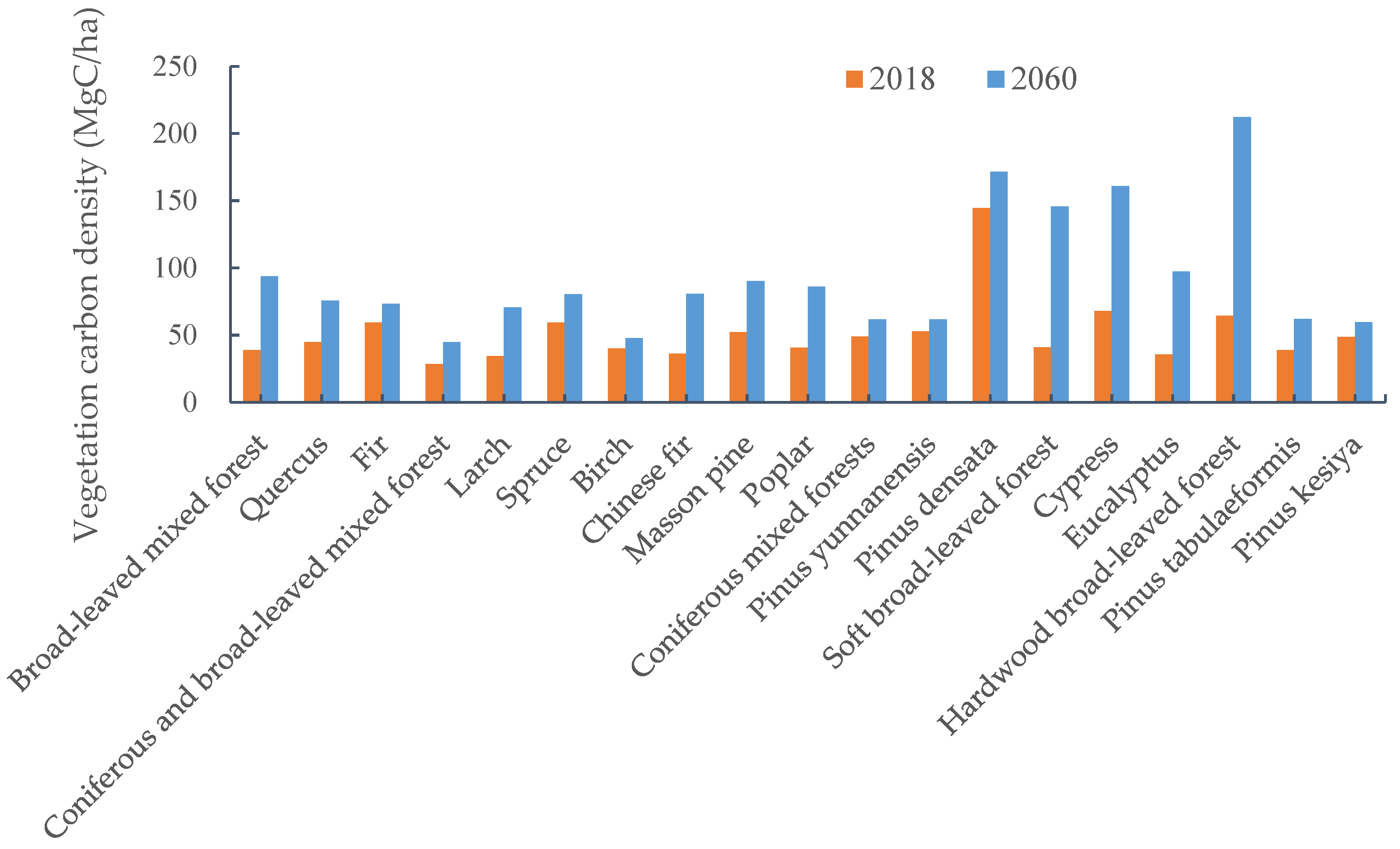
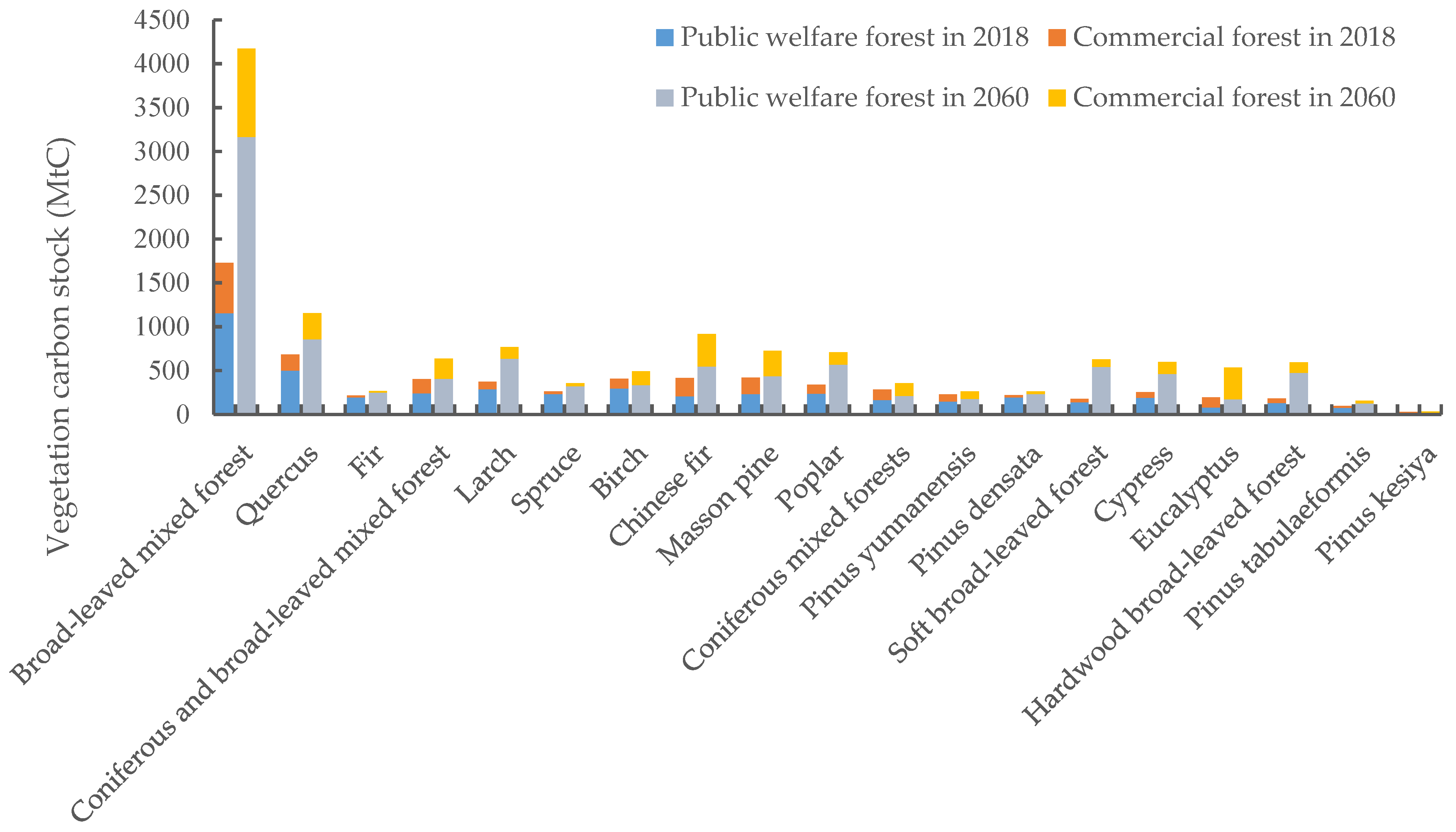
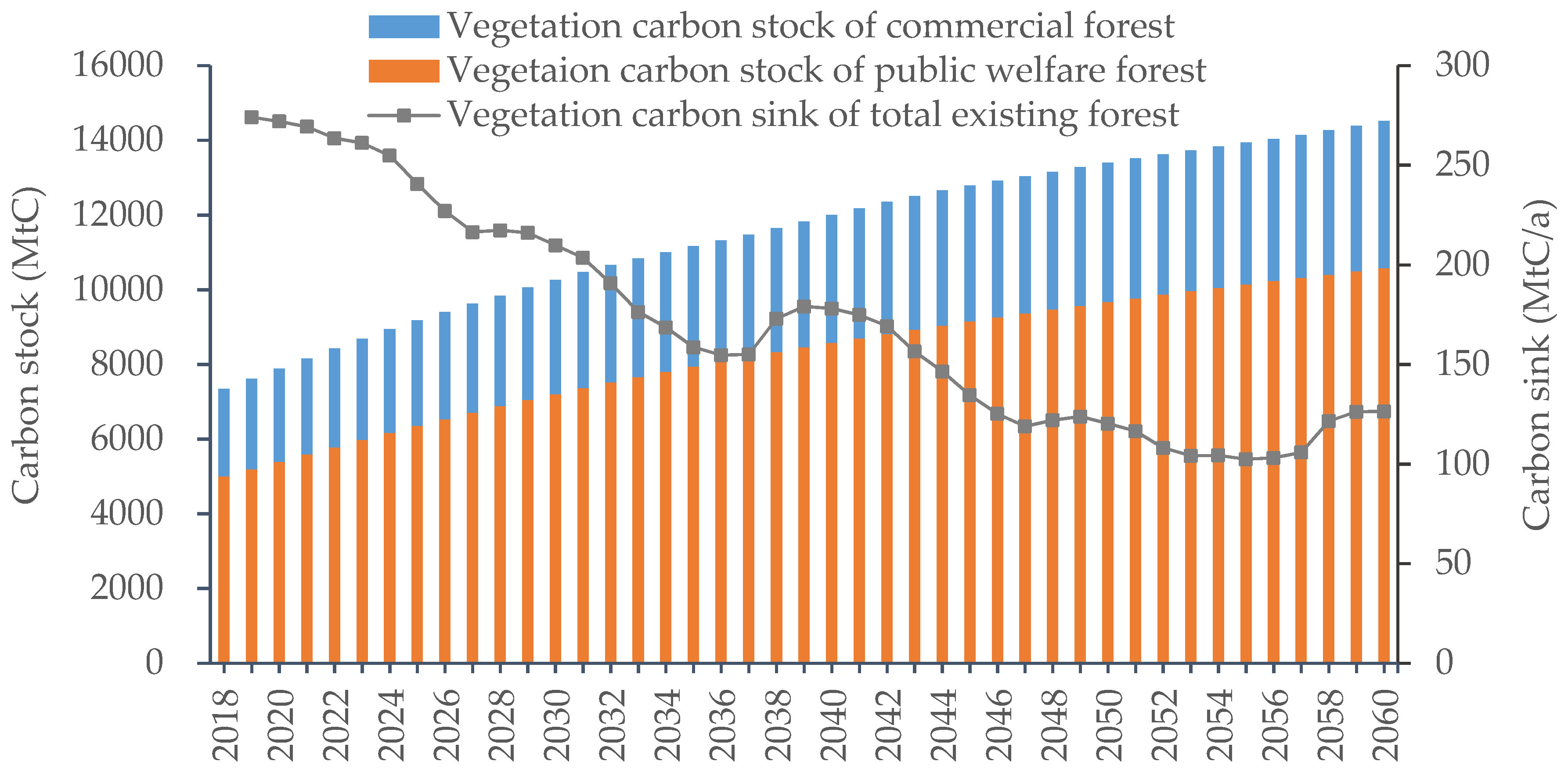
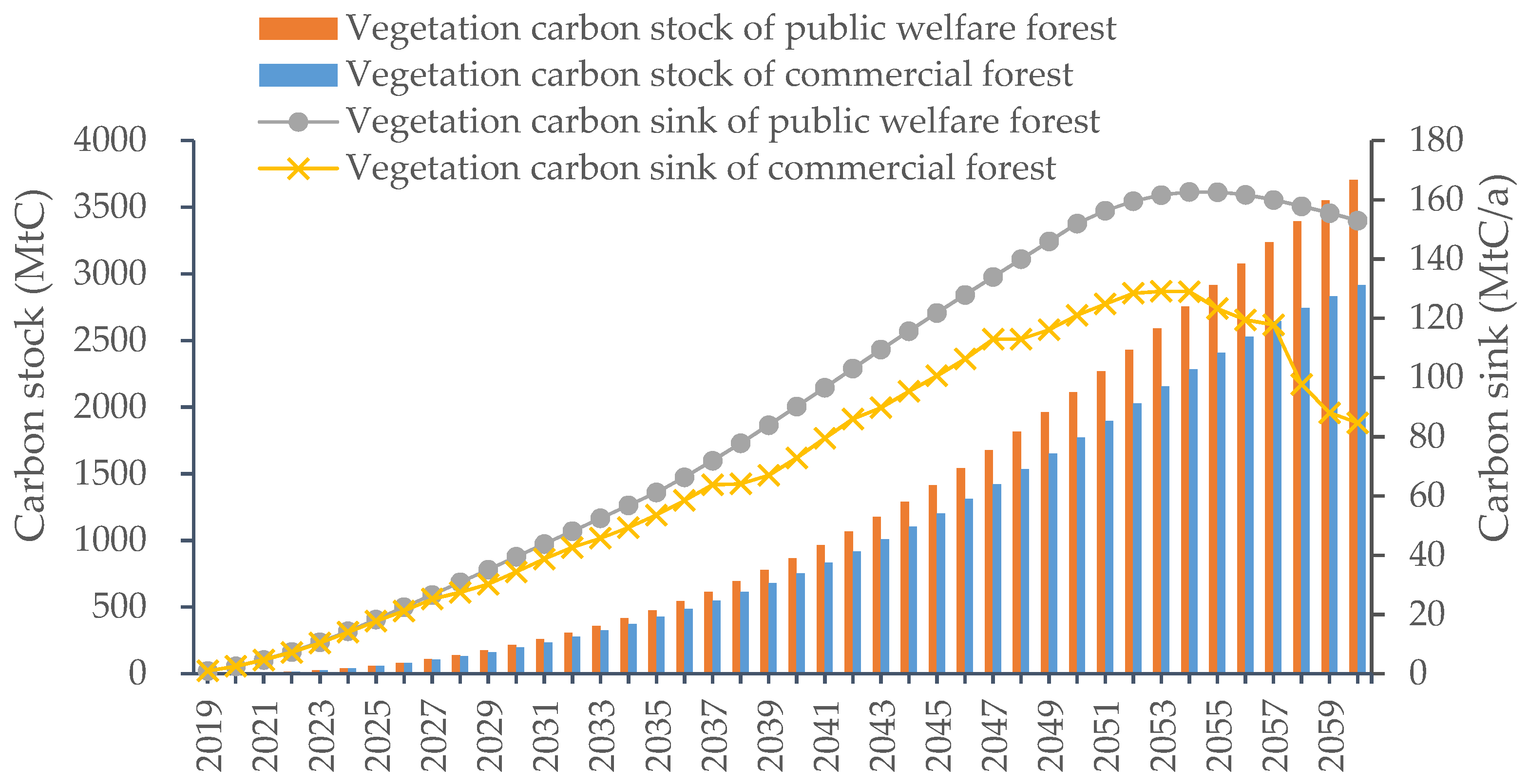
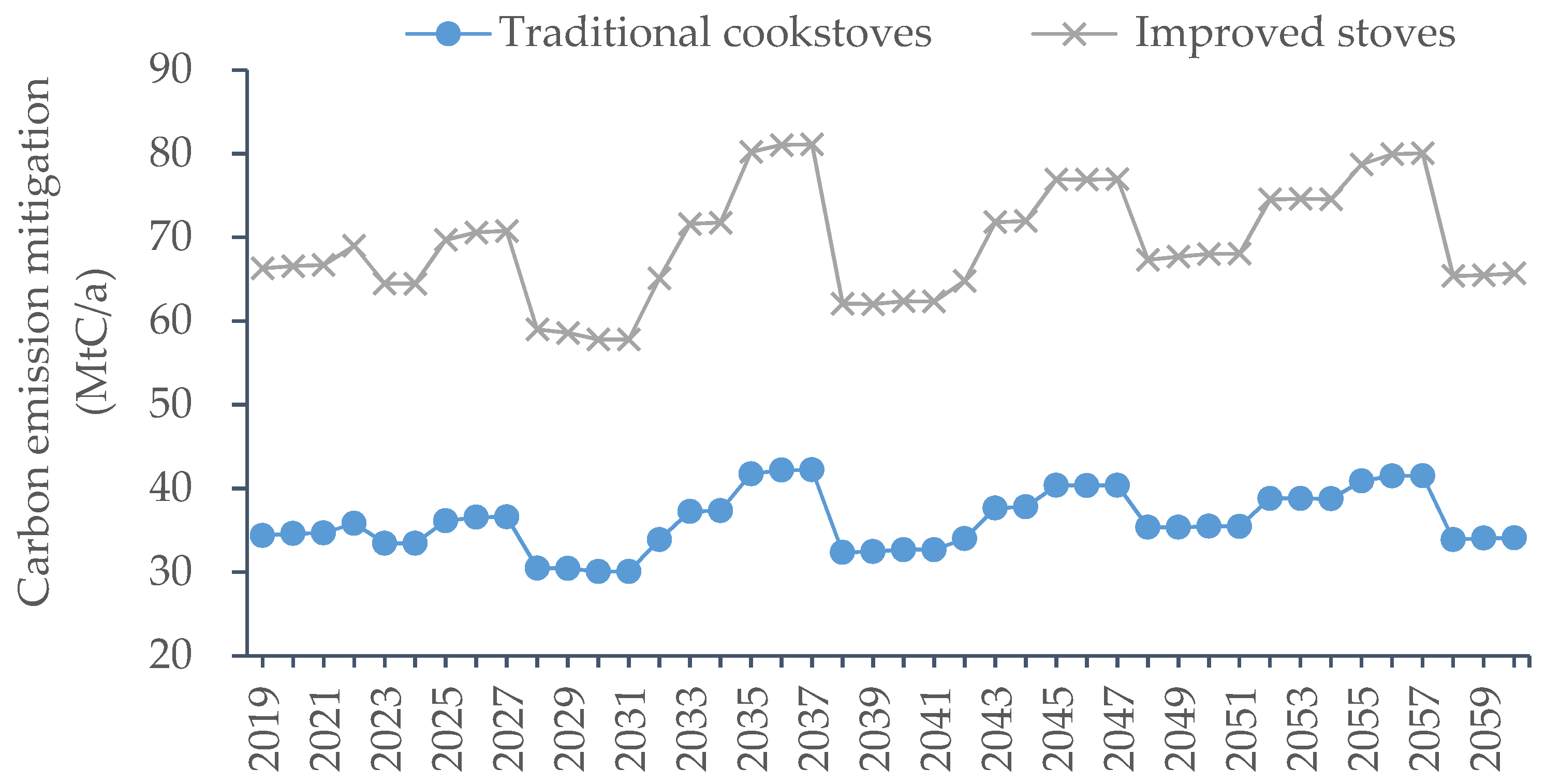
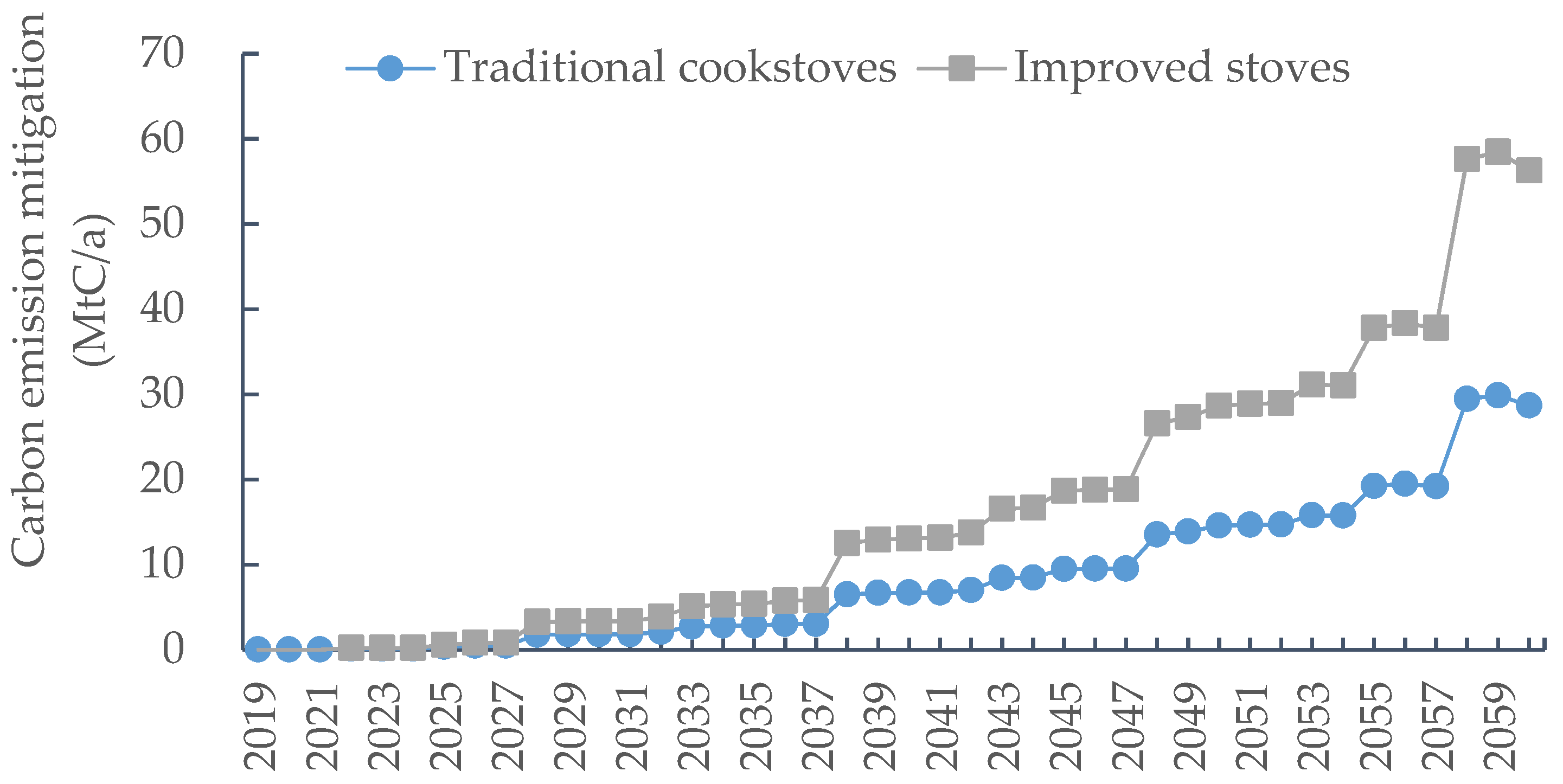
| Tree Species | Volume (Mm3) | Area (Mha) | ||
|---|---|---|---|---|
| Public Welfare Forest | Commercial Forest | Total | ||
| Broad-leaved mixed forest | 4390.4 | 24.6 | 19.9 | 44.5 |
| Quercus | 1386.6 | 9.9 | 5.4 | 15.3 |
| Fir | 1325.0 | 2.9 | 0.7 | 3.6 |
| Coniferous and broad-leaved mixed forest | 1241.5 | 7.6 | 6.6 | 14.2 |
| Larch | 1123.0 | 7.7 | 3.2 | 10.8 |
| Spruce | 972.7 | 3.7 | 0.7 | 4.4 |
| Birch | 922.9 | 7.5 | 2.9 | 10.4 |
| Chinese fir | 852.0 | 4.9 | 6.5 | 11.4 |
| Masson pine | 626.1 | 3.7 | 4.3 | 8.0 |
| Poplar | 612.4 | 5.2 | 3.1 | 8.3 |
| Coniferous mixed forests | 574.7 | 3.0 | 2.8 | 5.8 |
| Pinus yunnanensis | 501.0 | 2.4 | 1.9 | 4.3 |
| Pinus densata | 332.4 | 1.2 | 0.3 | 1.5 |
| Soft broad-leaved forest | 302.6 | 2.8 | 1.5 | 4.3 |
| Cypress | 232.0 | 2.5 | 1.2 | 3.7 |
| Eucalyptus | 215.6 | 1.8 | 3.6 | 5.5 |
| Hardwood broad-leaved forest | 154.0 | 1.7 | 1.1 | 2.8 |
| Pinus tabulaeformis | 145.1 | 1.8 | 0.6 | 2.5 |
| Pinus kesiya | 61.6 | 0.3 | 0.3 | 0.6 |
| Tree Species | Stem (%) | Root (%) | Foliage (%) | Branch (%) |
|---|---|---|---|---|
| Quercus | 44.34 | 42.26 | 45.86 | 44.73 |
| Spruce, Fir | 47.54 | 48.54 | 50.67 | 49.35 |
| Coniferous and broad-leaved mixed forest | 48.12 | 48.03 | 47.22 | 47.6 |
| Larch | 47.52 | 47.02 | 47.09 | 47.77 |
| Birch | 45.61 | 45.19 | 47.55 | 47.98 |
| Chinese fir | 47.71 | 43.17 | 47.95 | 46.52 |
| Masson pine | 47.91 | 45.96 | 49.8 | 48.32 |
| Poplar | 46.09 | 43.76 | 44.8 | 46.13 |
| Pinus kesiya, Pinus densata, Coniferous mixed forests | 47.32 | 47.27 | 49.28 | 48.78 |
| Pinus yunnanensis | 47.91 | 45.96 | 49.8 | 48.32 |
| Soft broad-leaved forest | 45.21 | 43.5 | 44.55 | 44.38 |
| Cypress | 48.33 | 46.13 | 50.53 | 48.31 |
| Eucalyptus | 45.5 | 45.23 | 46.18 | 45.3 |
| Broad-leaved mixed forest, Hardwood broad-leaved forest | 45.36 | 43.68 | 45.61 | 45.39 |
| Pinus tabulaeformis | 47.36 | 45.92 | 49.68 | 48.3 |
| Fuel | Technology | Emission Factors (g/kg) | References | ||||
|---|---|---|---|---|---|---|---|
| CO2 | CH4 | N2O | CO | TNMOC | |||
| Coal | Anthracite stoves | 2876.26 | 8.78 | 0.04 | 58.49 | 5.82 | [52] |
| Forestry bioenergy | Traditional cookstoves | 0 | 9.4 | 0.08 | 64.7 | 9.65 | [29] |
| Improved stoves | 0 | 7.92 | 0.06 | 69.5 | 6.84 | ||
| Tree Species | Public Welfare Forest | Commercial Forest | Total |
|---|---|---|---|
| Broad-leaved mixed forest | 2012.7 | 433 | 2445.8 |
| Quercus | 357.9 | 113.4 | 471.4 |
| Fir | 55.5 | −3.9 | 51.6 |
| Coniferous and broad-leaved mixed forest | 163.4 | 67 | 230.5 |
| Larch | 348.2 | 46.4 | 394.5 |
| Spruce | 87.5 | 4.6 | 92.1 |
| Birch | 38 | 43.6 | 81.5 |
| Chinese fir | 341.4 | 163.5 | 504.8 |
| Masson pine | 203.3 | 102.2 | 305.5 |
| Poplar | 330.2 | 43 | 373.2 |
| Coniferous mixed forests | 44.9 | 28.5 | 73.4 |
| Pinus yunnanensis | 27.2 | 10 | 37.2 |
| Pinus densata | 38.8 | 2.4 | 41.2 |
| Soft broad-leaved forest | 403.5 | 48.5 | 452 |
| Cypress | 272 | 72.5 | 344.5 |
| Eucalyptus | 93.5 | 244.9 | 338.4 |
| Hardwood broad-leaved forest | 346.2 | 67.4 | 413.6 |
| Pinus tabulaeformis | 48.8 | 8.6 | 57.5 |
| Pinus kesiya | 2.6 | 3.5 | 6.1 |
| Scenario | Category | 2018 | 2020 | 2030 | 2040 | 2050 | 2060 |
|---|---|---|---|---|---|---|---|
| China’s total arbor forests (new afforestation for public welfare forests) | Area (Mha) | 179.9 | 183.3 | 200.5 | 224.1 | 254.2 | 254.2 |
| Vegetation carbon stock (MtC) | 7344.8 | 7894.4 | 10,480.9 | 12,871.4 | 15,510.0 | 18,219.1 | |
| Vegetation carbon sink (MtC/a) | — | 274.5 | 249.4 | 268.3 | 272.3 | 279.4 | |
| Vegetation carbon density (MgC/ha) | 40.8 | 43.1 | 52.3 | 57.4 | 61.0 | 71.7 | |
| China’s total arbor forests (new afforestation for commercial forests) | Area (Mha) | 179.9 | 183.3 | 200.5 | 224.1 | 254.2 | 254.2 |
| Vegetation carbon stock (MtC) | 7344.8 | 7894.4 | 10,463.3 | 12,757.3 | 15,169.9 | 17,430.7 | |
| Vegetation carbon sink (MtC/a) | — | 274.5 | 244.2 | 251.0 | 241.4 | 211.1 | |
| Vegetation carbon density (MgC/ha) | 40.8 | 43.1 | 52.2 | 56.9 | 59.7 | 68.6 |
Publisher’s Note: MDPI stays neutral with regard to jurisdictional claims in published maps and institutional affiliations. |
© 2022 by the authors. Licensee MDPI, Basel, Switzerland. This article is an open access article distributed under the terms and conditions of the Creative Commons Attribution (CC BY) license (https://creativecommons.org/licenses/by/4.0/).
Share and Cite
Ma, X.; Wu, L.; Zhu, Y.; Wu, J.; Qin, Y. Simulation of Vegetation Carbon Sink of Arbor Forest and Carbon Mitigation of Forestry Bioenergy in China. Int. J. Environ. Res. Public Health 2022, 19, 13507. https://doi.org/10.3390/ijerph192013507
Ma X, Wu L, Zhu Y, Wu J, Qin Y. Simulation of Vegetation Carbon Sink of Arbor Forest and Carbon Mitigation of Forestry Bioenergy in China. International Journal of Environmental Research and Public Health. 2022; 19(20):13507. https://doi.org/10.3390/ijerph192013507
Chicago/Turabian StyleMa, Xiaozhe, Leying Wu, Yongbin Zhu, Jing Wu, and Yaochen Qin. 2022. "Simulation of Vegetation Carbon Sink of Arbor Forest and Carbon Mitigation of Forestry Bioenergy in China" International Journal of Environmental Research and Public Health 19, no. 20: 13507. https://doi.org/10.3390/ijerph192013507
APA StyleMa, X., Wu, L., Zhu, Y., Wu, J., & Qin, Y. (2022). Simulation of Vegetation Carbon Sink of Arbor Forest and Carbon Mitigation of Forestry Bioenergy in China. International Journal of Environmental Research and Public Health, 19(20), 13507. https://doi.org/10.3390/ijerph192013507








